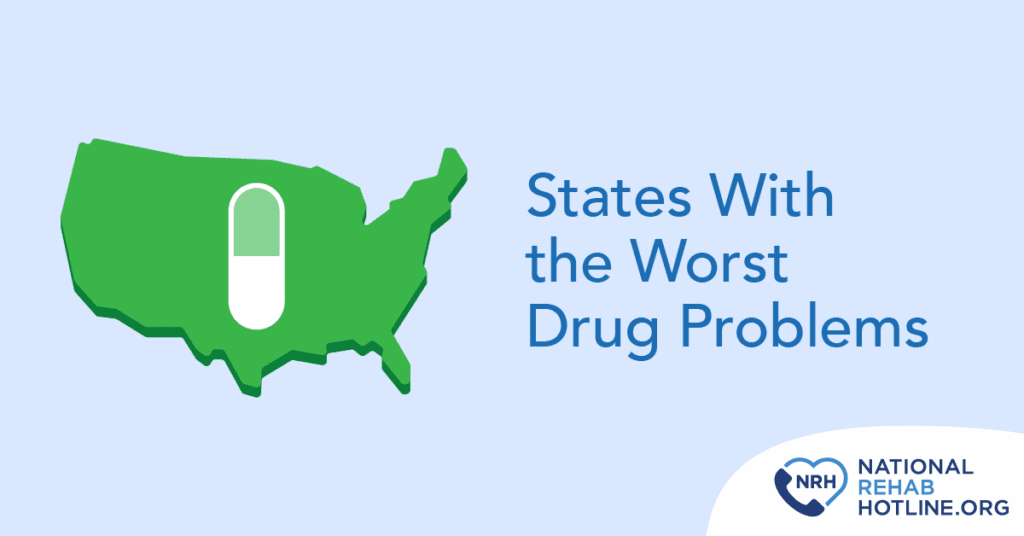For more than 50 years, The War on Drugs has persisted, but drug abuse remains a crisis in the United States. Each year, millions of people across all demographics and states use illegal drugs or abuse legal substances, and more than 100,000 of those die. While all 50 states are committed to addressing the drug abuse issues facing their communities, some have been more effective than others. The highest drug use by state may reflect ineffective policies or over-prescription of opioids originally marketed to prescribers as nonaddictive.
Let’s look at how drug use differs by state and determine what strategies states might adopt to improve their performance.
Measuring Drug Abuse: Key Statistics
While no single metric shows the total severity of the drug problem affecting a state, the number of overdose deaths is a critical factor. To better understand which states face the greatest problem, let’s start by looking at which states lose the most people annually to overdose, adjusted for population. According to data from the U.S. Centers for Disease Control and Prevention, the states with the highest drug overdose deaths per 100,000 people are:
- West Virginia – 80.9
- Tennessee – 56
- Delaware – 55.3
- Louisiana – 54.5
- Maine – 54.3
- Kentucky – 53.2
- New Mexico – 50.3
- Vermont – 45.9
- Ohio – 45.6
- South Carolina – 44.7
In raw numbers, California, Texas, New York and Florida are always at the top of the list of states with high numbers of overdose deaths simply because these states have large populations. But once adjusted to a per-capita rate, it’s easy to see that drug use by state tends to be higher in areas of Appalachia and the South. Washington, D.C., would also make the list with a rate of 64.3, but the nation’s capital is broken out separately since it isn’t counted in any state results.
While people in any demographic can struggle with addiction, states with high overdose rates often have challenges that include economic distress, high opioid prescription rates and limited access to addiction treatment services.
When looking at overall illicit drug use, SAMHSA lists nine states and the District of Columbia that fall into the highest percentile range of 18.98-23.99. These states are Alaska, Washington, Oregon, Nevada, New Mexico, Colorado, Rhode Island, Vermont and Maine. While some overlap exists between the two lists, there’s also a substantial difference. More people using and abusing drugs doesn’t always translate to a higher death toll.
Factors Contributing to the Highest Drug Use by State
Several factors contribute to the high rates of drug abuse in these states. Socioeconomic conditions play a significant role. High rates of poverty or unemployment can be major contributing factors to depression and struggles handling stress. When organizing a list of the highest drug use by state, there’s often a correlation with lower median household incomes.
Another major factor is the over-prescription of opioids. Many states on the list were hit hard by the opioid epidemic due to aggressive marketing and prescribing of painkillers in the 1990s and 2000s. West Virginia, Kentucky and Tennessee, for example, saw some of the highest opioid prescription rates in the nation before efforts were made to curb the crisis.
Health care access is another key determinant. States with limited availability to addiction treatment centers and mental health services struggle to provide adequate support for individuals battling substance use disorders. Rural areas, in particular, often lack sufficient resources, forcing individuals to travel long distances for treatment or go without.
Social and Economic Impacts of Drug Addiction
Drug abuse is expensive for everyone. It’s costly for users, who often already struggle with underemployment and unemployment, and it’s costly for society as a whole. Drug abuse places a massive burden on the health care system, with emergency rooms and rehabilitation centers overwhelmed by overdose cases. Some rural hospitals close due to the unsustainable costs of providing care to uninsured or underinsured patients battling addiction.
Economically, drug addiction costs the economy in terms of productivity levels and employment opportunities. There’s an increased demand for social services and more workplace accidents and absenteeism. Businesses that can’t find and keep employees face a significant financial burden that prevents growth.
Higher crime rates, increased dependence on state child welfare programs and other costs associated with the justice system drive up the toll on everyday communities.
Efforts to Combat the Drug Crisis
In response to the drug epidemic, federal, state and local governments have implemented various initiatives to reduce substance abuse and its consequences. Legislative measures have played a crucial role in addressing the crisis. For example, many states have enacted prescription drug monitoring programs to track opioid prescriptions and prevent doctor shopping. Stricter regulations on opioid prescribing have helped curb initial addiction rates.
Harm reduction strategies have also gained traction. The widespread distribution of naloxone, a medication that reverses opioid overdoses, has saved countless lives. But treatment and recovery programs remain a cornerstone of combating drug addiction. States that invest in expanding access to medication-assisted treatment, counseling and rehabilitation services see better outcomes in reducing substance use disorders. However, funding for these programs remains a challenge, particularly in states with limited health care budgets.
Community outreach and education efforts are also crucial. Many high-risk states have launched public awareness campaigns aimed at reducing the stigma surrounding addiction and encouraging treatment. Grassroots organizations and nonprofits have stepped up to provide support, resources and advocacy for those affected by drug abuse.
Fighting Drug Use By State: Get Help Today
The states with the highest drug use are grappling with a crisis that affects every aspect of society, from public health and the economy to crime rates and family stability. If you or a loved one is dealing with addiction or substance abuse, call the National Rehab Hotline today. Our trained counselors are standing by to connect you with the help you need in your area.

